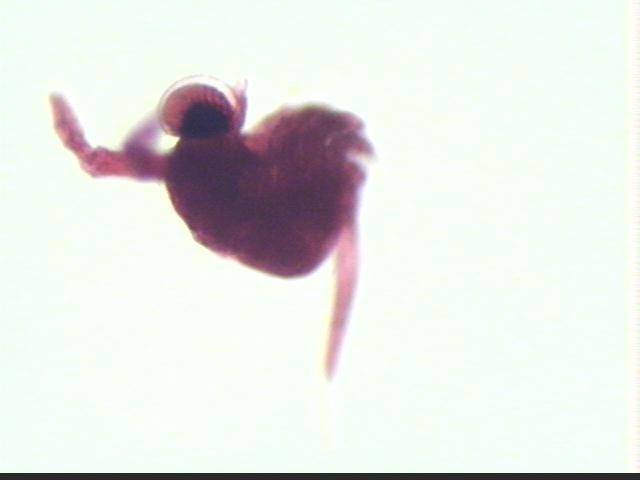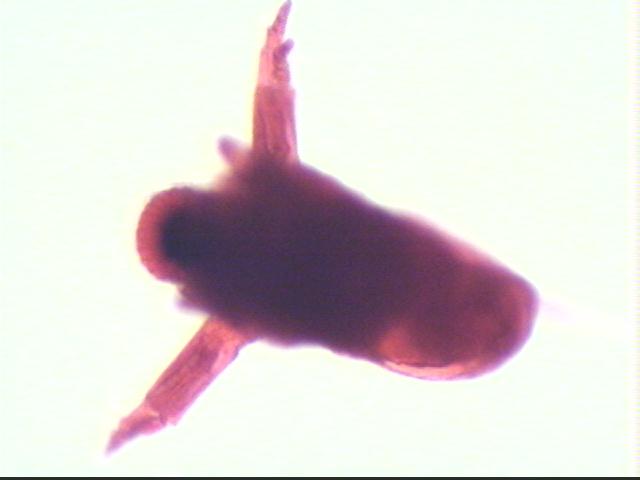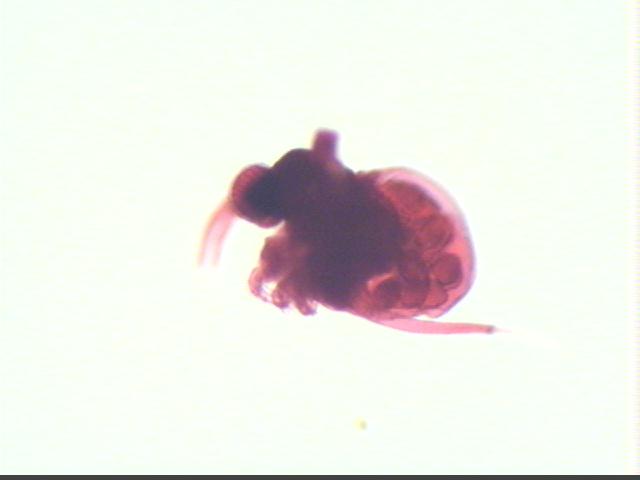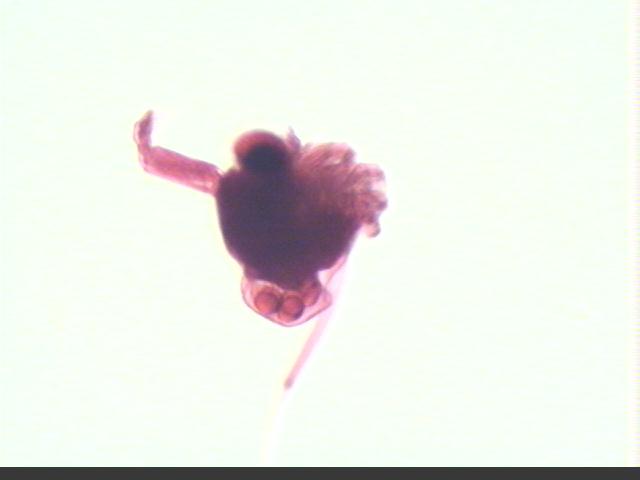|
Classification Kingdom - Animalia The family Polyphemidae has six genera and 18 species. Two of the genera are primarily marine (Edmondson 1959). Polyphemus pediculus is the only native freshwater species of the family Polyphemidae in North America (Edmondson 1959). Polyphemus pediculus was named by Linne in 1761. Anatomy Polyphemus pediculus is recognizable by its reduced carapace, globular brood chamber, large eye, and elongate abdomen terminating in two long setae (Figures 1, 2, 3, and 4). The brood sac is globular and can hold twenty to twenty-five young in full grown females (Balcer et al. 1984) ( Figure 3). The antennules are very small and are on the ventral surface of the head. The head is large and has a huge moveable eye ( Figures 1 and 4). The antennae have seven setae on each ramous. Their legs have strong claws and branchial appendages (Edmondson 1959). Females can grow to a length of 1.5cm and males only to 0.8cm (Edmondson 1959). Distribution and Habitat P. pediculus prefer to live in marshes and in the weedy regions of ponds and lakes. P. pediculus shows preference for upper water strata a few meters below the surface, but has been found in the open waters of large lakes (Edmondson 1959). This organism has been found in all of the Great Lakes, in mid to late summer samples (Balcer et al. 1984). Feeding P. pediculus chases its prey, leaps onto it, grasps and squashes it before grinding it with powerful mandibles. Polyphemus pediculus is a size dependent predator. The distance between their grasping legs (Figure 4) puts a maximum limit on the size of prey that can be handled (Young and Taylor 1988). Features of their chasing behavior, include pauses, periods of shadowing the target at a constant distance and the outcome of the chase; contact making or chase termination (Young and Taylor 1988). Polyphemus pediculus avoid making contact with small or large targets. This suggests that they can estimate the size of their target by visual cues (Young and Taylor 1988). In chasing prey P. pediculus first swims along behind a target. It matches the targets swimming speed by maintaining the target image at an angle close to 14 degrees. This is the shadowing phase. If there is a sudden increase in the targets size appearance, the predator pauses. This results in the target getting close without the chaser expending energy and providing less of a chance at being spotted by its prey (Young and Taylor 1988). To determine the actual size of the prey P. pediculus rapidly accelerates which brings it closer to the target. The target will increase in angular size. There is an inverse relationship between the perceived size increase and the actual size of the target (Young and Taylor 1988). Growth and Reproduction Cladocera have two methods of reproduction, sexual (gametogenetic), and asexual (parthenogenetic) reproduction. The sexual and asexual reproduction of P. pediculus are ensured by different types of females. They differ in morphology, physiology, life cycles, and behavior (Butorina 2000). Male production and sexual reproduction will generally occur in late autumn in north temperate lakes and ponds. P. pediculus does not produce ephippial resting eggs, like most cladocerans. Their restings eggs usually fall to the sediments, or become attached to aquatic macrophytes (Weider 1989). Asexual females do not lay eggs. Eggs mature in the brood pouch, where they are nourished by maternal secretions of nutritive fluid (Weider 1989). Young sexual females are small with small brood chambers and resting eggs that are still in the ovaries. The caudal stems of these females are blue to violet (Butornia 2000). Older sexual females have large brood chambers that contain resting eggs (Butorina 2000). Their sexual openings are blocked by hardened internal membranes in the brood chamber. These females can no longer copulate and have a change in color to warn males of this (Butorina 2000). The dorsal side of their brood chamber changes to a red-brown color and the caudal stem becomes dark blue. Males can detect these color changes from 30cm away (Butorina 2000). |
Polyphemus pediculus 
Figure 1: The large eye of the predator Polyphemus pediculus makes this Cladoceran recognizable. 
Figure 2: The large swimming appendages shown in this photo are important in movement of the animal. 
Figure 3: In this photo the brood pouch containing eggs is clearly visible. The terminal setae can also be seen. 
Figure 4: In this photo the a terminal setae, swimming arm, raptorial appendages (used for predation and feeding), brood pouch and large eye can all be seen. |
Works Cited Butorina, L. G. 2000. A Review of the Reproductive Behavior of Polyphemus pediculus (Crustacea: Branchiopoda). Hydrobiology. 427: 13-26. Young, S. and Taylor, V.A. 1988. Visually guided Chases in Polyphemus pediculus. Journal of Experimental Biology. 137: 387-398. Weider, L .J. 1989. Population Genetics of Polyphemus pediculus (Cladocera: Polyphemidae). Heredity. 62: 1-10. Edmondson, W.T. 1959. Freshwater Biology 2nd Edition. John Wiley and Sons Inc. London-Chapman and Hall Limited. New York, USA. p1248. Balcer, Korda, and Dodson. 1984. Zooplankton of the Great Lakes: A Guide to the Identification and Ecology of the Common Crustacean Species. University of Wisconsin Pres. Madison, Wisconsin. |
